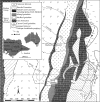Oldest coelacanth, from the Early Devonian of Australia
- PMID: 17148426
- PMCID: PMC1686207
- DOI: 10.1098/rsbl.2006.0470
Oldest coelacanth, from the Early Devonian of Australia
Abstract
Coelacanths are well-known sarcopterygian (lobe-finned) fishes, which together with lungfishes are the closest extant relatives of land vertebrates (tetrapods). Coelacanths have both living representatives and a rich fossil record, but lack fossils older than the late Middle Devonian (385-390 Myr ago), conflicting with current phylogenies implying coelacanths diverged from other sarcopterygians in the earliest Devonian (410-415 Myr ago). Here, we report the discovery of a new coelacanth from the Early Devonian of Australia (407-409 Myr ago), which fills in the approximately 20 Myr 'ghost range' between previous coelacanth records and the predicted origin of the group. This taxon is based on a single lower jaw bone, the dentary, which is deep and short in form and possesses a dentary sensory pore, otherwise seen in Carboniferous and younger taxa.
Figures


Similar articles
-
Earliest known coelacanth skull extends the range of anatomically modern coelacanths to the Early Devonian.Nat Commun. 2012 Apr 10;3:772. doi: 10.1038/ncomms1764. Nat Commun. 2012. PMID: 22491320
-
Molecules, fossils, and the origin of tetrapods.J Mol Evol. 1992 Aug;35(2):102-13. doi: 10.1007/BF00183221. J Mol Evol. 1992. PMID: 1501250 Review.
-
First discovery of a primitive coelacanth fin fills a major gap in the evolution of lobed fins and limbs.Evol Dev. 2007 Jul-Aug;9(4):329-37. doi: 10.1111/j.1525-142X.2007.00169.x. Evol Dev. 2007. PMID: 17651357
-
A primitive fish close to the common ancestor of tetrapods and lungfish.Nature. 2002 Aug 15;418(6899):767-70. doi: 10.1038/nature00871. Nature. 2002. PMID: 12181564
-
Lungfish evolution and development.Gen Comp Endocrinol. 2006 Sep 15;148(3):285-9. doi: 10.1016/j.ygcen.2005.10.010. Epub 2005 Dec 7. Gen Comp Endocrinol. 2006. PMID: 16337631 Review.
Cited by
-
The most detailed anatomical reconstruction of a Mesozoic coelacanth.PLoS One. 2024 Nov 6;19(11):e0312026. doi: 10.1371/journal.pone.0312026. eCollection 2024. PLoS One. 2024. PMID: 39504317 Free PMC article.
-
A Late Devonian coelacanth reconfigures actinistian phylogeny, disparity, and evolutionary dynamics.Nat Commun. 2024 Sep 12;15(1):7529. doi: 10.1038/s41467-024-51238-4. Nat Commun. 2024. PMID: 39266502 Free PMC article.
-
The evolution of the various structures required for hearing in Latimeria and tetrapods.IBRO Neurosci Rep. 2023 Mar 22;14:325-341. doi: 10.1016/j.ibneur.2023.03.007. eCollection 2023 Jun. IBRO Neurosci Rep. 2023. PMID: 37006720 Free PMC article.
-
Common evolutionary origin of acoustic communication in choanate vertebrates.Nat Commun. 2022 Oct 25;13(1):6089. doi: 10.1038/s41467-022-33741-8. Nat Commun. 2022. PMID: 36284092 Free PMC article.
-
The Natterin Proteins Diversity: A Review on Phylogeny, Structure, and Immune Function.Toxins (Basel). 2021 Jul 31;13(8):538. doi: 10.3390/toxins13080538. Toxins (Basel). 2021. PMID: 34437409 Free PMC article. Review.
References
-
- Brinkmann H, Venkatesh B, Brenner S, Meyer A. Nuclear protein-coding genes support lungfish and not the coelacanth as the closest living relatives of land vertebrates. Proc. Natl Acad. Sci. USA. 2004;101:4900–4905. doi:10.1073/pnas.0400609101 - DOI - PMC - PubMed
-
- Chang, M.-M. 1982 The braincase of Youngolepis, a Lower Devonian crossopterygian from Yunnan, south-eastern China. Ph.D. thesis, Stockholm: University of Uppsala.
-
- Chang M.-M, Yu X.-B. Structure and phylogenetic significance of Diabolichthys speratus gen. et sp. nov., a new dipnoan-like form from the Lower Devonian of eastern Yunnan, China. Proc. Linn. Soc. NSW. 1984;107:171–184.
-
- Cloutier R. The primitive actinistian Miguashaia bureaui Schultze (Sarcopterygii) In: Schultze H.-P, Cloutier R, editors. Devonian fishes and plants of Miguasha, Quebec, Canada. Dr. Friedrich Pfiel; München: 1996. pp. 227–247.
-
- Cloutier R, Ahlberg P.E. Morphology, characters, and the interrelationships of basal sarcopterygians. In: Stiassny L.J, Parenti L.R, Johnson G.D, editors. Interrelationship of fishes. Academic Press; San Diego, CA: 1997. pp. 445–479.
Publication types
MeSH terms
LinkOut - more resources
Full Text Sources


